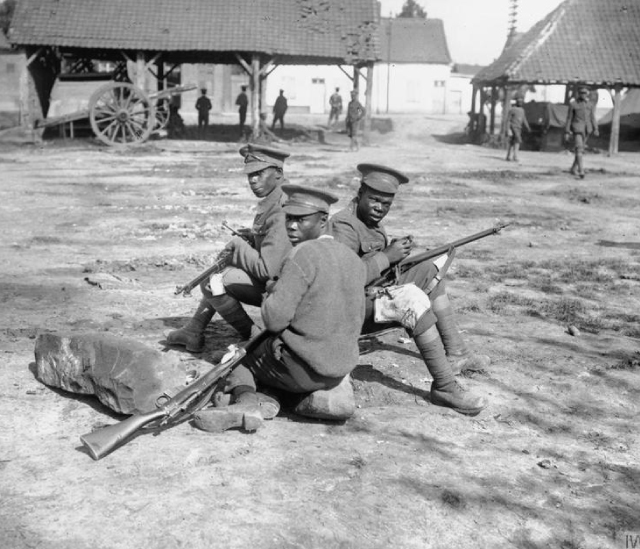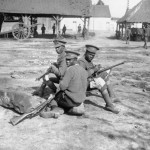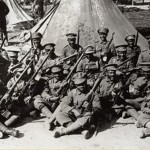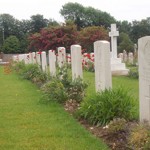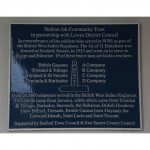Read this article to learn about West Indian soldiers in the First World War.
West Indian and African soldiers provided much needed manpower in fighting the First World War but also faced extreme prejudice.
When war was declared in 1914, the West Indies offered to send contingents of men to fight alongside Britain. The British West Indies had been part of the British Empire since the 17th century. In total, 16,000 soldiers were recruited in the West Indies along with 4,500 volunteers who were also sent to the war.
Whilst Britain was more than happy to accept these men from the West Indies, they were far more opposed to using black African soldiers on European battlefields. African soldiers were common in the French army during the First World War, with around 450,000 men being deployed in their armies. However, Britain eventually banned the use of black African soldiers in their own armies in Europe.
Additionally, the German army was fiercely opposed to the use of black African soldiers in Europe, going so far as to produce a pamphlet which suggested that colonial soldiers were committing war crimes and atrocities on German soldiers such as the cutting off of ears, hands, or heads as trophies.
Ongoing German propaganda often portrayed black soldiers as uncivilised demons or apes who would destroy all forms of pre-war civilisation. Allied propaganda would attempt to counter these arguments by referring back to Germany’s supposed lack of civilisation for starting the war in the first place, but would also represent their own black soldiers in similar ways or portray Germany in a manner which echoed racial stereotypes.
Men from the West Indies arrived in Sussex prepared to fight side by side with the British army. A camp was created at Seaford to be used to train and prepare the 1st Battalion of the West Indies Regiment for the fighting taking place in Europe and beyond.
However, much like the Indian soldiers’ initial deployment in France or the men of the Chinese Labour Corps, the soldiers arriving from the West Indies did not have an easy trip to Britain or Europe. The initial journey to Britain was hazardous and, when their ships were diverted via Halifax in Canada, hundreds of men were left with severe frostbite. Many were left unfit for service and were sent back to the West Indies with no compensation or benefits.
The winter of 1914/15 was particularly cold and harsh. The West Indian soldiers were confined to poor accommodation and unsuitable clothing for the duration of the winter and, as a result, their health and morale began to suffer. Following this, a bout of pneumonia which had afflicted numerous men and an epidemic of mumps then swept through the camp.
The West Indian Regiment would go on to play a crucial role in the First World War, especially in Palestine and Jordan, where they were deployed against the forces of the Ottoman Empire. During this fighting, General Allenby sent a telegram to the Governor of Jamaica:
I have great pleasure in informing you of the gallant conduct of the machine-gun section of the 1st British West Indies Regiment during two successful raids on the Turkish trenches. All ranks behaved with great gallantry under heavy rifle and shell fire and contributed in no small measure to the success of the operations.
Thousands of men from the West Indies had campaigned to be allowed the right to fight alongside Britain at the start of the war. However, in a cruel twist of fate, by the war’s conclusion, the West Indian soldiers were on the verge of mutiny in the Italian camp of Taranto. Manpower shortages had left the West Indian soldiers facing hard physical and demeaning labour, such as the building and cleaning of toilets for white soldiers. When they discovered that white soldiers in the camp had received pay rises whilst they had not it tipped the regiment over the edge.
The mutiny lasted for around 4 days and, at its conclusion, 60 soldiers were tried and convicted. Most received prison sentences from 3 to 5 years while one soldier was sentenced to 20 years in prison and another was executed by firing squad.
The mutiny may have subsided but the feelings behind it had not. Many West Indian soldiers deciding that they would strike for higher pay when they were returned home. However, the islands of the West Indies had seen violent protests during the final years of the war. The British were so concerned by these that they had moved warships into West Indian ports to stop any possible uprising.
Fearing that returning West Indian soldiers to this situation may cause further problems, the decision was taken to send 4,000 West Indian soldiers to Cuba and Venezuela and leave them there instead. Many would be forced to stay and never see their homelands again.
19 West Indian soldiers died in the Seaford training camp and their bodies are buried in a military cemetery there. In November 1994, for the first time, a memorial service was held, attended by Second World War veterans from the West Indies Ex-Service Men and Women’s Association of London. They were possibly the first to visit their compatriots in 80 years. In 2006, family members from the West Indies visited the graves of West Indian soldiers in Seaford.
In November 2015, the first ever English Heritage approved Blue Plaques in Seaford town were unveiled to commemorate the centenary of the formation of the British West Indies Regiment in 1915. A Blue Plaque was placed in Seaford Cemetery, Alfriston Road, to remember the 19 Caribbean soldiers who are buried there.
The unveiling ceremony was followed by the annual 2 minute silence at 11 o’clock by the West Indian Association of Service Personnel. Guests then moved on to unveil a second plaque at Seaford railway station.
Questions
1) How were black soldiers viewed during the war?
2) What were conditions like for West Indian soldiers in Seaford?
3) Where were 4,000 West Indian soldiers sent after the war?
Images
- Men of the West Indies Regiment cleaning their rifles. Amiens-Albert Road. Courtesy of Brighton & Hove Black History Group
- Men of the West Indies Regiment in a camp near the Amiens-Albert Road. Courtesy of Brighton & Hove Black History Group
- French poster celebrating the ‘Day of the African Army and Colonial Troops’. 1917
- West Indian graves in Seaford. Courtesy of Brighton and Hove Black History Group
- Memorial Blue Plaque for the West Indian Regiment in Seaford
Click here to download a copy of this resource: First World War – West Indian Soldiers – students

